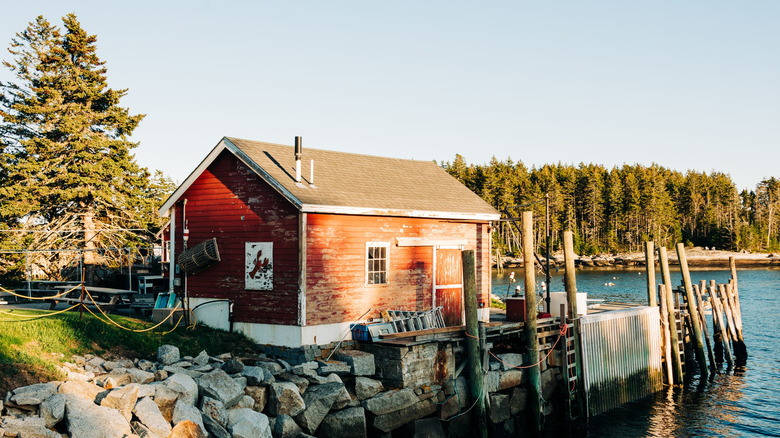Maine's Hidden Gem With A Historic Downtown And Antique Shops Is Known As The 'Town That Went To Sea'
As the largest of New England's six coastal states, Maine has no shortage of beautiful seaside towns. From Kennebunkport's charming streets and delicious seafood to Bar Harbor's lively waterfront — two towns that double as New England road trip highlights — it's no wonder Maine has a reputation as a coastal resort haven. But for those looking to avoid the crowds, Thomaston, one of Maine's hidden gems, flies happily under the radar. With a population of less than 2,800 people, this historic town in Knox County sits quietly between Rockland and the St. George Peninsula. Known as "the Town that Went to Sea", Thomaston is a place where shipbuilding history, antique shops, and lobster rolls come together.
"The Town that Went to Sea" isn't just a catchy nickname; it's a nod to Thomaston's deep maritime roots. Thomaston was once America's wooden shipbuilding center. In fact, at the height of the shipbuilding era in 1840, more wooden ships were built here than in any other state in America. Thomaston's builders were especially famous for their tall-masted schooners and full-rigged ships, each constructed with meticulous precision at impressive speed.
At its peak, three of America's seven millionaires lived in this little coastal town, all shipbuilders and captains who literally built their fortunes by hand. The town's roots date back to its settlement by the British in 1605. For centuries, Thomaston's greatest asset was its forests, whose wood was used to carve masts and hulls for British ships. The town's protected harbor became a haven for vessels sheltering from hurricanes and Atlantic storms, while the St. George River (technically more of a tidal passage to the Atlantic Ocean that's replete with clams and fish), served as the community's lifeline.
Thomaston's maritime history and storied state prison
Thomaston is perhaps best known for housing the Maine State Prison between 1824 and 2002 — the very same institution that inspired Stephen King's fictional penitentiary in "The Shawshank Redemption." Over its nearly two-century history, the prison evolved dramatically. It began as a grim fortress with underground holding pits where prisoners were lowered each night before being put to work at the local stone quarry each day. After a fire in 1923, the facility changed shape again, eventually relocating entirely to a more modern prison in 2002. While the main building has been demolished, visitors can still learn about the prison's legacy at the Maine State Prison Showroom, and even purchase handmade products made by current inmates.
Thomaston's history is preserved by the Wessaweskeag Historical Society, a nonprofit dedicated to maintaining the region's historical archives and artifacts, library, and community events. The society's most notable project has to be Thomaston's Museum in the Streets, an open-air museum concept that turns the entire town into a historical walking tour. Scattered across the town, there are 25 plaques displaying old photographs taken from the very same spots over 125 years ago, paired with stories and information about each specific area's past.
It's a fascinating glimpse into Thomaston's past, allowing visitors to literally stand where the town's history happened and see how much it has evolved over more than a century. The outdoor museum is laid out in a T-shaped configuration, starting from the old prison site and ending at the waterfront. Walking through Thomaston feels like stepping back into a 19th-century shipbuilding village, with beautifully preserved architecture on display at the Town Office, Public Library, and quaint shops that line Main Street.
Exploring Thomaston's timeless antique scene
Today, life in Thomaston moves at a gentle pace. Along with its neighbor, South Thomaston (a coastal resort town known for its lobster and beaches), the area draws in a mix of young families and retirees. Staying true to its roots in craftsmanship, Thomaston has made a name for itself as a hub for antique collectors. Main Street is lined with charming antique shops like Anchor Farm Antiques and Ross Levett Antiques, with the famous Thomaston Place Auction Galleries leading the pack. Recognized by both Christie's and Sotheby's, this world-class auction house is a major player in the antique scene, hosting regular auctions featuring rare artifacts and fine art, museum-quality curios, and jewelry sourced from around the globe. And if that's not enough antiquing to sate your desire, consider taking the 2-hour drive south to Wells, a town with plenty of antique shops and collections in its own right.
Thomaston's personality shifts with the seasons. Spring is mild and perfect for outdoor activities. Summers are warm but not too hot, while fall brings incredible opportunities for leaf peeping. Winter is the town's quietest season, when conditions are often rainy or snowy.
Getting there is pretty straightforward, although public transportation is limited. The Knox County Regional Airport, just 7 miles from Thomaston, handles limited JetBlue and Cape Air flights to and from Boston. For more options, travelers can fly into Portland International Jetport, Maine's major airport, which offers cross-country connections with carriers like Delta, Southwest, JetBlue, United, and American Airlines. Depending on the route, it's about a 76- to 90-mile drive to Thomaston. Once in town, Thomaston is easily explored on foot, with plenty of charming guesthouses and cozy boutique hotels to stay in.


